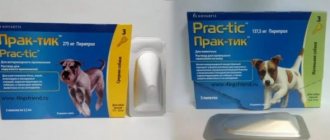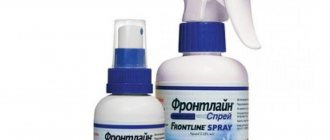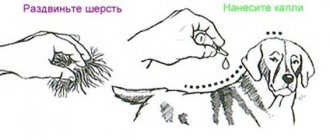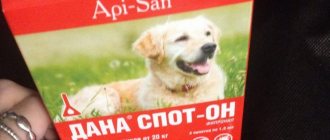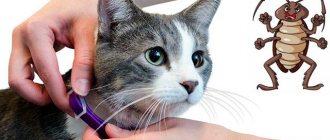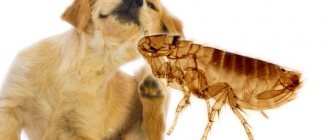The appearance of fleas on a pet can become a serious problem. Especially if we are talking about a small puppy. Many owners, having seen external parasites on their pet, are lost and do not know how best to rid their baby of them.
Currently, drops are considered one of the most effective means for killing fleas. But can they be used not only for adult dogs, but also for the smallest puppies? And how to do it correctly?
Causes of fleas in dogs
A dog can become infected with fleas through direct contact with a sick animal.
Other routes of infection are also possible:
- In the entrance, elevator or transport (if there was an infected animal there previously).
- On a walk. Fleas and their larvae can be found in grass and fallen leaves, on the soil. Parasites have the ability to jump, so they can easily move into the pet’s fur.
- On the hunt. A dog can become infected by digging up wild animal burrows or coming into contact with bird nests.
- On shoes and clothes. Fleas and larvae can be brought into the home by dog owners.
- Puppies become infected from a sick mother.
After getting rid of fleas, there is a risk of secondary infection if parasite larvae remain on the bedding, floor or furniture.
Female fleas do not attach eggs to the animal's fur, but scatter them. For this reason, it is necessary to carefully treat furniture and floor coverings in the house while treating your dog. The pet's sleeping place should be replaced.
Home → Useful tips → Treating dogs for fleas and ticks
Everything you need to know about treating dogs for fleas and ticks.
— Why do you need to treat dogs for ticks?
Ticks are carriers of a number of diseases - piroplasmosis, anaplasmosis, ehrlichiosis, theileriosis. In addition, feeding mites cause anxiety to the animal, and a large number of them on small animals can even lead to anemia (anemia).
—At what age can puppies be treated for fleas and ticks?
Treatment is possible from the age of two months. It is very important to treat adult dogs and cats living with a puppy for fleas and ticks.
— Preparations for ticks and fleas in dogs, how to treat your dog?
Frontline, Vectra, Rolf Club, Hartz, Prak-tik - drops on the withers; Bravecto, Nexgard - flea and tick tablets.
—Is it possible to use different tick and flea treatments at the same time on dogs?
(drops, collars, sprays, key chains, tablets)? It is possible to use drops on the withers or tablets together with collars, the active substance should be different.
— How to properly treat a dog for ticks?
Spot-on preparations (drops) are applied behind the ears and down the neck area from above, to those places from which the dog cannot lick them off. The tablets are given orally without food. It is important to apply flea and tick medications based on your pet's weight.
— How to treat a dog for ticks if it weighs less than 2 kg?
Nexgard or Bravecto tablets should not be used in animals weighing less than 2 kg. Such animals should be treated with drops on the withers in a dosage half as much as needed for dogs weighing 2-4 kg, that is, use half a pipette.
— Treating dogs against ticks before vaccination/castration, are there any special features? Surgical interventions leave a negative imprint on the functioning of the animal’s immune system, but do not affect the number of fleas on it, so flea and tick treatments are necessary. It is recommended to do this 10 days before the intended procedure.
—Is it possible to treat a dog with anti-tick medications and anti-worm tablets at the same time?
Yes, you can. Inspector is a complex preparation in the form of drops on the withers, which, when absorbed into the blood, have a destructive effect on both fleas and ticks and helminths. Such drops are more convenient to use, since treating the animal will take less time and there is no need to give deworming tablets. The drug Nexgard Spectrum also works. If you use different drugs, then it would be correct to treat for ticks and for worms on different days.
—How often should you treat your dog for ticks and fleas?
When using drops on the withers - once a month before frost in the fall and start again in the spring, when the snow begins to melt. If your animal communicates with dogs or cats that may have fleas, then treatment does not need to be stopped even in winter. If the animal is washed more than twice a month, it is recommended to reduce the interval between treatments to 3 weeks. Bravecto tablets are given once every 3 months, Nexgard - once a month.
—Flea and tick tablets for dogs, are they safe?
Yes, it's safe. All active ingredients included in the tablets have class 4 toxicity, that is, if the dosage is observed, they do not affect the animal’s internal organs and metabolism. At the same time, carefully read the instructions or consult a veterinarian before taking the tablets, since each active ingredient has its own contraindications.
—If my dog vomits 2 hours after taking a flea and tick tablet, does it need to be re-treated with the drug?
Yes, I need it. But you need to make sure that vomiting was not a side reaction to the pill. To re-treat, you should use drops on the withers, and also examine the dog for stomach or intestinal diseases.
—Is it possible to treat a dog against ticks and fleas with medications for cats?
Not necessary, since the active ingredients and their dosage are different for dogs and cats. Moreover, it is strictly forbidden to treat cats with drops and tablets for dogs, since some of the active ingredients included in their composition can lead to the death of the cat.
—What side effects can there be from anti-tick medications?
There should be no side effects or complications in animals when applying drops to the withers according to the instructions with correct dosage. If there is increased individual sensitivity to the components of the drug and signs of allergic reactions appear, the treatment is stopped, the drug is washed off with water, and antihistamines are given orally. When using tablets, individual sensitivity is possible, manifested by vomiting and diarrhea. If your animal is seriously unwell, you should contact a veterinarian.
—What diseases can a tick bite cause in a dog?
The most common is piroplasmosis. More difficult to diagnose are borreliosis, theileriosis, ehrlichiosis, and anapasmosis. In any case, all these diseases are extremely dangerous for the health of your pet. Therefore, it is much easier to carry out preventive treatments against ticks than to treat these pathologies.
—The dog was bitten by a tick. Symptoms .
With piroplasmosis, the following symptoms are observed: fever, dark urine, weakness of the pelvic limbs, lethargy, refusal to eat, the animal drinks a lot. In later stages, the skin and mucous membranes become yellow. Symptoms of other diseases are less specific and may include lameness, lethargy, increased local temperature, vomiting, anemia and diarrhea. Fortunately, not all ticks carry any pathogen. In any case, redness and swelling will form at the site of the bite, which can cause discomfort to the animal, so it is better to remove the tick.
—My dog was bitten by a tick, what should I do?
Contact a veterinary clinic immediately. They will remove the tick, do a blood test for piroplasmosis, and, if necessary, prescribe treatment and supportive care.
—When can you wash your dog before and after tick and flea treatment?
You can wash it no earlier than 5 days after treatment. It is also advisable not to wash the dog for at least 2-3 days before, since shampoo washes away the fatty layer of the skin in which the active ingredient of the drug is distributed.
— Do I need to re-treat my dog for ticks and fleas if after treatment the animal is exposed to rain?
Usually not necessary if at least a few hours have passed since treatment. If the animal is caught in the rain after a few minutes of heavy downpour, and all the drug is washed away, then it should be treated again after 3-5 days.
— Is it necessary to treat a dog for ticks and fleas if it is completely domestic?
It is absolutely necessary, since fleas can be carried on shoes and clothes; this is also true if the animal lives on the 1st-4th floors - fleas move extremely easily and find victims. It is all the more important to prevent flea infestations, because getting rid of these parasites in an apartment is quite difficult
—Do I need to treat my apartment when treating my dog for fleas and ticks?
If your dog is heavily infested, most likely there are also a large number of fleas living in the house. They are not stationary parasites (that is, they do not live on the dog permanently and do not reproduce on it). Fleas lay their eggs in the environment, that is, in the carpet, blankets and clothes, from which they can only be expelled with special preparations.
—What and how is the best way to treat your apartment for fleas and ticks?
Solutions of Butox or Neostomozan, which are diluted according to the instructions. The apartment is washed, all carpets, rugs and other plush items, including dog bedding, are washed. You can moisten the door mat with the above solutions. With a strong infestation, owners often cannot cope with fleas on their own, especially if they live on the first floor. In these cases, it is better to use the services of a pest control service.
Symptoms of infection
Itching in a dog may be the first symptom of fleas.
At the initial stage of the disease, the presence of fleas can be recognized by the following signs:
- restless sleep (the animal moves from one place to another, shudders);
- sudden jumping up (the dog arches unusually and freezes for a few seconds);
- biting teeth into skin;
- the appearance of bald spots, increased shedding;
- constant intensive scratching.
Against the background of the disease, the animal may exhibit nervous, sometimes aggressive behavior. Even with timely nutrition, a dog can lose weight.
Diagnosis of parasites
At the first suspicion of infection, you should first examine the pet's fur and skin. In small numbers, adult fleas may go undetected during visual inspection.
Signs of the presence of parasites:
- In the area of the base of the tail, on the surface of the thighs, abdomen, groin and neck, papulocrustous areas are observed, causing severe itching.
- Light grains (parasite eggs) or dark spots (flea feces) are visible on the fur. Traces of the presence of insects are easier to notice when combing the animal against the growth of the fur. As the disease progresses, the number of insects increases, eggs and excrement of parasites are found on the litter and in the pet’s areas.
- When wounds become infected from scratching, ulcers appear on the skin and eczema develops.
You can confirm the presence of fleas while bathing. Parasites do not tolerate water and when an animal is immersed in a bath, they jump out onto a dry place.
If you have symptoms of the disease, you should contact your veterinarian to rule out skin diseases or other types of parasites. To do this, a scraping is carried out from the skin area, a microscopic examination of the fur and a cytological examination of skin infiltrates. Diagnostics using a Wood's lamp is prescribed.
Are fleas dangerous for humans?
Fleas feed on the blood of warm-blooded animals; human blood is just as attractive to them. However, insects cannot parasitize the human body due to the lack of hair. They are capable of biting people upon contact with an infected animal or when there is a sick dog in the house.
After saturation, the parasites jump off the person in search of suitable places to lay eggs.
Fleas can carry more than a dozen types of infectious diseases. Insect bites cause itching and allergic reactions are possible.
Pros and cons of flea drops for dogs
Compared to other forms of flea medications, drops have a number of advantages. One of them is ease of use.
Other advantages:
- high efficiency in the treatment and prevention of the disease;
- durability of the result (up to 3 months after treatment);
- quick processing (takes 5-10 minutes);
- low toxicity;
- Possibility of dosing depending on the weight and age of the pet.
The disadvantage of drops is the possibility of developing side effects in case of overdose. Other negative aspects: a strong odor and untidy appearance of the wool in the areas of treatment (lasts from 2 to 7 days).
Flea drops for dogs.
Criteria for choosing antiparasitic drops for dogs
Any veterinary pharmacy today will offer the buyer a large assortment of anti-flea drugs. Drops on the withers are also presented in a wide variety. What should you pay attention to when choosing such funds?
Select drops according to your dog's age
There are clear parameters on the basis of which the drug is purchased for a specific dog:
- age (flea drops for puppies will definitely be marked, from what week they can be used);
- size (standardly dogs are divided into the following weight categories: up to 10, 10 - 20, 25 - 40, over 40 kg);
- coat length;
- Possibility of use on pregnant or lactating dogs;
- cost of the drug.
Typically, all these parameters are indicated directly on the drug packaging. In addition, many manufacturers today even offer customers a list of breeds for which certain drops are best suited. This also greatly simplifies the process of choosing an effective and safe drug.
However, the most reliable way is to purchase a flea control product after consulting a veterinarian.
An experienced specialist will definitely advise which drops are best suited for an adult dog or puppy of a particular breed.
Actions and side effects
After application, the medicine enters the fatty layer of the animal, penetrates the skin, sebaceous glands and hair follicles. During the bite, the parasite receives a dose of medication, which causes disruption of its motor activity (nerve impulses are blocked) and death. The drug does not enter the animal’s blood, which eliminates the possibility of intoxication (subject to the dosage).
Drops may differ in composition.
The following insecticides may be present as active ingredients:
- pyrethroids;
- phenylpyrazoles;
- neonicotinoid compounds;
- phosphorus-containing substances.
Pyriproxyfen and methoprene are juvenile insecticides and are ineffective against adult insects. Their action is aimed at interrupting the development process of the insect at the stage of eggs and larvae. Preparations based on these substances are used as additional ones.
It is necessary to ensure that the animal does not lick the medicine immediately after application. Otherwise, poisoning with a toxic substance is possible. A visit to the veterinarian and gastric lavage will be required.
If the dosage is not observed, side effects may develop:
- restless behavior;
- severe trembling;
- bowel dysfunction;
- vomit;
- lacrimation;
- increased salivation;
- rapid breathing.
In case of overdose, it is recommended to bathe the dog by rinsing the skin and fur. Undesirable symptoms will disappear within 1-2 days.
Any product can cause an allergic reaction in an animal.
Effective Advantix and Advocate products
Among dog breeders who are willing to spend more significant sums on ensuring the well-being of their pets, products from such a well-known German concern as Bayer Health Care are popular. This manufacturer produces drops for the withers under two brands: Advantix and Advocate. The first product uses the synergistic effect of insecticides such as permethrin and imidacloprid. Thanks to this, Advantix drops are most effective against fleas, ticks and other ectoparasites.
These drops are widely known among owners of elite breed dogs.
Advocate's base ingredients are imidacloprid and moxidectin. This combination helps not only to destroy and expel fleas, but also to help cure many diseases associated with the presence of ectoparasites. Thus, the list of indications includes diseases such as otodectosis, sarcoptic mange, demodicosis, dirofilariasis, crenosomosis, etc.
It is because of this wide range of therapeutic effects that this drug is often prescribed by veterinarians.
Bayer anti-flea drops are convenient to buy, as they are divided into groups depending on the weight of the dogs. The packaging immediately indicates what size animals the proposed dosage is suitable for. At the same time, both drugs are considered very safe and extremely rarely give any side effects. Fleas are destroyed in just 12 hours. However, unlike the stronger Leopard, it provides only 1 month of protection against repeated parasitic infestation.
Review of the best products
Before using the medicine, it is recommended to conduct a sensitivity test. A drop of the product is applied to the withers or neck, the result is assessed after 10 or 12 hours.
There are a number of the most effective drops.
Drug Bars
Bars drops for dogs.
The Russian drug contains fipronil. The market also offers Bars Forte drops, which contain substances that regulate the growth of insects (they act on adults and larvae).
The product is sold in pipettes. The medicine remains effective for 3 months.
Drops should not be used on dog breeds weighing less than 2 kg and on puppies under 3 months. The product is contraindicated during pregnancy, injuries and chronic diseases.
Sanofly drug
The active substance of this product is cyfluthrin. Russian-made drops are produced in a bottle with a dispenser. The protective effect lasts for a month, after which it is recommended to repeat the treatment.
The product should not be applied if there is damage to the skin.
Vetpreparat Advocate
Drops from a German manufacturer (Bayer) are produced in pipettes. The solution contains moxidectin and imidacloprid. Repeated treatment is carried out after 30 days.
The product is contraindicated for puppies under 7 weeks of age and pets who have recently undergone surgery or illness.
In-Up product
Drops contain fipronil, aversectin and praziquantel. Manufactured by a Russian pharmaceutical company. Release form: bottles with a dropper.
The product is contraindicated for collie, sheltie, bobtail and their mixed breeds. Drops should not be used on a pet during pregnancy.
Advantix drops for dogs
The product is produced by the German company Bayer and contains 2 substances: imidacloprid and permethrin. For convenient dosed application, pipette tubes are provided. The medicine protects against relapse within a month. The drug is contraindicated for dogs weighing less than 1.5 kg and with weakened immunity.
Drops Dana Ultra Neo
The active ingredients of the Russian drug are pyriproxyfen, fipronil and thiamethoxam. Drops are available in the form of tubes. The effect of the drug lasts for one and a half months.
The product is contraindicated for puppies under 2.5 months and pregnant animals.
Drug Stronghold
American-made drops contain selamectin and are effective against fleas and larvae. Available in tubes. The protective effect lasts 1 month, after which the treatment can be repeated.
The product should not be used on puppies under 2 months of age.
Veterinary drug Insectostop
Ukrainian-made drops contain fipronil. Available in droppers. Maintain a protective effect for up to 60 days.
The product is contraindicated for puppies under 10 weeks of age and animals with weak immune systems.
Drops Frontline
The French drug is available in the form of pipettes.
Frontline drops for dogs.
Available in several composition options:
- fipronil (Spot-On);
- fipronil and permethrin (Tri-Act);
- fipronil and methoprene (Combo).
Depending on the composition, the medicine provides protection against infection for up to 60 days.
Drops cannot be used on breeds weighing less than 2 kg.
Rules for using drops on the withers
However, if the drug is applied to the animal’s body in strict accordance with the attached instructions, no overdose should occur. Watch this video for more details:
Applying drops to the withers is quite simple. It is important to follow several principles:
- Correct dosage. It is very easy to adhere to it, since modern drugs are produced in special pipettes. Medicines are sold in different dosages for different sizes of dogs.
- Correct application. It is important here that the drops get on the animal’s skin. If he has long hair, you need to part it, drop the required amount of the drug onto the skin and rub it in with light massage movements. It is also important to apply the product to that area of the body where the animal cannot reach with its tongue. That's why the drops are rubbed into the withers. Some medications are recommended to be applied behind the ears.
- Monitoring the dog's general well-being. In the first hours, it is advisable to monitor whether your pet is showing signs of an overdose of a toxic drug. In addition, if there is more than one dog at home, it is important to prevent the possibility of one animal licking the poison from the body of another.
- Bathing. You need to read the instructions exactly after how long the dog can be bathed. Most modern drugs are waterproof, so bathing is often possible after just a few hours.
- Compliance with general rules of personal hygiene. You also need to worry about your health when it comes to using toxic substances. It is advisable to wear rubber gloves when applying drops. During the procedure, you should not eat, drink, or touch your face with your hands. After completing all the manipulations, you must thoroughly wash your hands and rinse those parts of the body where even a small amount of the drug accidentally came into contact.
Thus, the rules for using drops against fleas are very simple. The most important thing is to choose the right drug that combines high efficiency in destroying ectoparasites with sufficient safety for the animal being treated. Here it is necessary to adhere to specific criteria for choosing a suitable product.
Features of drops for puppies
Drops can be used to treat puppies older than 2 months (unless additional age restrictions are specified in the instructions). At a younger age, alternative methods are used to get rid of fleas. Most medications are suitable for puppies older than 3 months.
The younger the puppy is, the less aggressive substances are selected for treatment (careless use of drops may result in dry skin and poisoning).
It is recommended to visit a veterinarian before starting treatment.
Wide selection of Hartz UltraGuard drops
Even more expensive drugs against fleas and other ectoparasites are drops from such a well-known Canadian manufacturer as Hartz.
A significant advantage here is that the drops are available in different versions: for dogs of all weight and age categories.
In addition, you need to pay special attention to the names. If the drops are simply called Hartz UltraGuard, then the active ingredient here is phenothrin. If the PRO label is added to the name, in addition to phenothrin, methoprene is also present. But Hartz UltraGuardPLUS drops are based on the combined toxic effect of d-phenothrin and S-methoprene. This composition will be most effective against both adult fleas and ticks and larvae.
Hartz Ultraguard is designed for dogs of a wide range of breeds and sizes.
All Hartz products are highly effective. In addition, they have almost no contraindications. However, these drops are not recommended for use on dogs weighing less than 1.8 kg or on puppies under 12 weeks of age. In general, dog breeders who use these products leave positive reviews about them. However, it is often pointed out that the comparative effect of these drops does not always correspond to their high cost.
Rules for antiparasitic treatment
Handling your pet should be done with gloves. During the day, you should not pet the animal and allow children near the dog.
Drops are applied to dry skin. Afterwards, they must be rubbed into the skin with smooth movements, unless the manufacturer specifies other recommendations.
Where to drip?
Before use, you should study the instructions, which may indicate the scheme for using the drops.
In most cases, the composition is applied to the following areas:
- withers;
- base of the neck;
- between the shoulder blades and further along the back along the spine.
The product cannot be applied to other areas of the body, because... From easily accessible areas, the dog can lick the medicine and become poisoned.
In areas of treatment, it is necessary to part the animal’s fur so that the composition gets on the skin.
How many drops should you apply?
Beaphar anti-flea drops for dogs.
Drops from all manufacturers are accompanied by instructions that indicate the exact dosages calculated based on the dog’s body weight. Therapeutic norms may differ between drugs.
The recommended dose of the composition is distributed over several areas on the body.
In what cases does it not help?
Anti-flea drops may not help if the type of parasite or disease is incorrectly identified. Intense itching in a dog can be caused by allergies or other insects.
Other possible reasons:
- The dosage by weight was not met. For large dog breeds, the amount of composition is increased according to the instructions.
- The pet's room and sleeping place were not sanitized.
To maintain the result, it is necessary to carry out timely re-treatment according to the manufacturer's instructions.
Large and small breeds
Most manufacturers produce drops designed for dogs of different sizes and this is not done on a whim. The fact is that the dose of the active drug included in such drops varies for large and small breeds.
It should also be taken into account that the volume of the pipette varies, and therefore the dose designed for small dogs may not be enough to properly treat a large breed pet.
Important! You should select drops for your pet according to its breed.
Folk methods of struggle
An alternative to chemical flea medications are methods related to traditional medicine recipes.
The following remedies are suitable for getting rid of parasites:
- Herbs. Decoctions are used for bathing or treating animal fur. Tansy, wormwood, eucalyptus and juniper fruits are effective against fleas.
- Essential oils. To treat your pet, soap-based solutions with the addition of cedar, castor or eucalyptus oil are used. You can use mint, juniper or lavender oil.
- Onion or garlic. Treating wool with an aqueous infusion of garlic or a soap solution with the addition of grated onion is effective.
- Laundry soap. You can make anti-flea shampoo at home. To do this, laundry soap is dissolved in a decoction of eucalyptus. Tea tree or cedar oil is added to the resulting solution.
- Salt. This method is suitable for small dogs. The pet needs to be dipped up to its neck in a bucket of salt solution (1 kg of salt is used per bucket of warm water).
- Pine sawdust. Parasites avoid contact with pine needles, so an additional effective measure to get rid of fleas would be to use bedding made from fresh pine sawdust. You can put wormwood branches under them.
- Vinegar. To treat wool, use apple cider vinegar diluted with water (to 1 part vinegar, 3 parts water).
The advantages of traditional methods are the lack of toxicity of the compositions and the low cost of raw materials. Disadvantage - they are inferior in effectiveness to pharmaceutical drugs.
Sentry anti-flea drops for dogs.
How to choose the right drug
You need to be careful when choosing drops for your pet. The wrong drug or dosage can cause great harm, even leading to poisoning. And if the dosage turns out to be too small, or the selected substance does not fit the parameters, then the dog will be left without the protection it needs.
When making a choice, pay attention:
- Country of origin.
- List of insects on which the drug acts. Not all of them help against ticks. And some are not suitable for fleas.
- Compound . If your dog is allergic, then carefully read the entire list of substances included in the liquid so as not to provoke an attack.
- Age . It is not recommended to use toxic liquids to treat puppies. Some manufacturers produce products suitable for 3-4 month old animals, but in general it is better not to apply drops until six months.
- Dog's weight . To ensure that the product is effective, choose a higher dosage. For example, if your dog weighs 20 kg, use a fluid designed for 20-40 kg, not 10-20 kg. Low weight is a serious contraindication for use. Decorative breeds weighing about 2 kg are better off abandoning this type of protection in favor of more natural ones, based on essential oils or herbal extracts, since the likelihood of pesticide poisoning for them is very high.
- Personal health limitations. Having settled on a specific brand. Carefully read the “contraindications” section in the instructions for use. If at least one point is true for your pet, do not risk applying it.
- This product should not be used by pregnant , lactating bitches, old or sick dogs.
The right choice is very important, since this is a serious product that can both provide high-quality protection and seriously harm your pet if used incorrectly.
For which dogs are drops contraindicated?
Before starting treatment, you should study the contraindications to the chosen remedy.
Any anti-flea drops cannot be used in the following cases:
- The dog's body weight is less than 1.5 kg.
- Individual intolerance to the components of the composition was revealed.
- The dog has an infectious disease.
A number of drugs are approved for treatment during pregnancy, but in such cases it is recommended to first consult a veterinarian.
Preventive actions
The most dangerous period for infection is spring-summer.
At this time, the following recommendations will help reduce the risk of disease:
- Wear a flea collar on your dog when walking.
- Carry out preventive treatments with a special shampoo.
- Regularly treat the dog's resting place with disinfectants.
- Avoid contact with unfamiliar animals.
- Do not walk in potentially dangerous places (abandoned areas, basements).
It is necessary to keep the dog clean and regularly inspect its coat.
Drops against ectoparasites FrontLine
Frontline antiparasitic agents are more economical than the previous option. The active ingredient here is fipronil, the effectiveness of which is enhanced by optimally selected additives. The product is sold in pipettes of various sizes. The packaging indicates what weight of dogs the specific dosage is intended for. Anti-flea protection against repeated infestations here lasts 2 months.
Quite standard contraindications are also indicated. It is not recommended for use on puppies under 10 weeks and on dogs whose weight has not reached 2 kg. Unlike Hartz and Bayer products, FrontLine drops are not as water resistant.
You can bathe your dog only 2 days after applying the drug.
In addition, if it gets exposed to rain earlier, the effectiveness of the drops will be significantly reduced. This is often the reason for negative reviews about these drops. In general, domestic dog breeders positively assess the price-quality ratio of anti-flea drops for dogs from FrontLine.
Reviews from dog owners
Natalya, 54 years old, Moscow: “Last year the dog picked up fleas while walking. We placed the pet in a bath of water and caught jumping fleas. Then the coat was dried and Frontline Merial drops were applied. Since then, they have forgotten about parasites. The dog’s sleeping area was also treated.”
Dmitry, 37 years old, Astrakhan: “When we found fleas on the dog, we washed it with shampoo and treated the withers with Hartz drops. At first the situation improved, but after a while the parasites reappeared.
At the appointment, the veterinarian explained that the cause of the relapse was the neglect of the need to disinfect the premises where the dog lives, because... Flea eggs can be found in flooring, behind baseboards and on furniture. The second time, everything was done correctly, the fur and skin were clean after treatment, 5 months have passed.”
Marina, 29 years old, St. Petersburg: “The dog started to itch, they suspected fleas, and treated it with drops. But the itching did not go away. The veterinarian carried out the necessary research and identified a fungus. After adequate treatment, the pet recovered. I regret that I didn’t show the dog to the doctor right away.”
Prices for medications for flea treatment of dogs
Russia
- Mr. Bruno, shampoo, 350 ml, from 260 to 280 rubles;
- Lugovoy, shampoo, 270 ml, from 140 to 155 rubles;
- Beaphar, shampoo, 250 ml, from 500 to 530 rubles;
- Bars(AVZ) Forte, drops, 4 pcs. 1.8 ml each, from 260 to 275 rubles;
- Frontline (Merial) Spot-On XL, drops, 4.02 ml, from 570 rub. up to 590 rub.;
- BlochNet max, drops, 1 pipette, from 130 to 145 rubles;
- Frontline (Merial), aerosol, 100 ml, from 950 to 1100 rubles;
- Beaphar Spot On Spray, spray, 400 ml, from 580 to 600 rubles;
- RolfClub, collar, from 255 to 270 rubles;
- Celandine, collar, from 90 to 100 rubles;
- Bravecto, chewable tablets, from 1250 to 1700 rubles;
- Eprimek, solution for injection, 100 ml, from 720 to 750 rubles.
Ukraine
- Phytoelite, shampoo, 220 ml, from 43 to 45 UAH;
- Frontline, spray, 250 ml, from 600 to 605 UAH;
- Bars, drops, 2 pipettes of 5 ml, from 114 to 115 UAH;
- Frontline, drops, 1 pipette, from 210 to 215 UAH;
- Bravecto, chewable tablets, from 680 to 685 UAH;
- Advocate, drops on the withers, 1 pipette, from 260 to 270 UAH;
- Bars, spray, 100 ml, from 107 to 110 UAH;
- Beaphar, collar, from 85 to 95 UAH;
- Mister Zoo, collar, from 15 to 20 UAH;
- Barrier, shampoo, 100 ml, from 20 to 22 UAH;
- Ivermectin-10, solution for injection, 50 ml, from 85 to 90 UAH.
